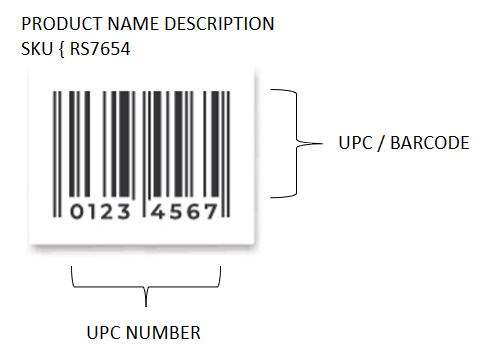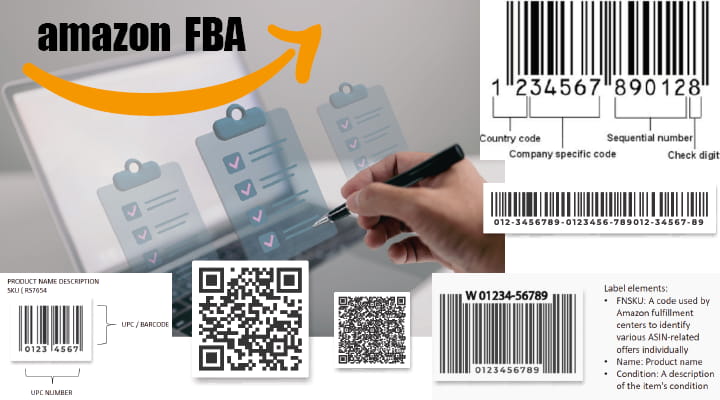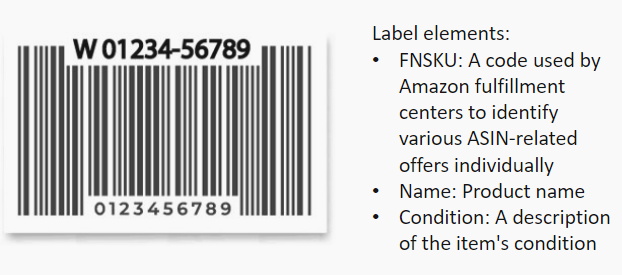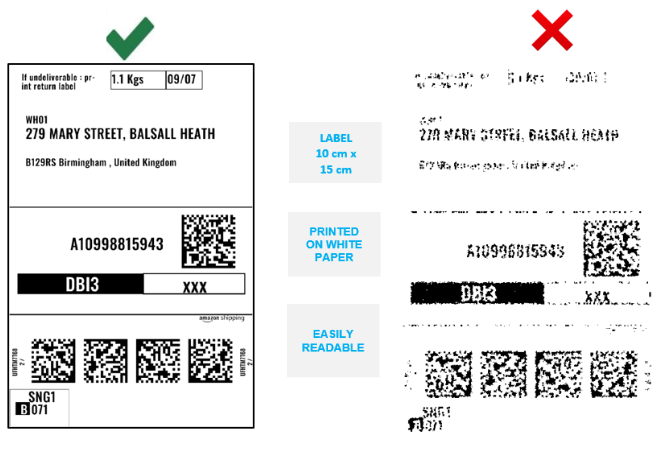
Seller SKU on Amazon
Seller SKU on Amazon is the short-term for Stock Keeping Unit. SKU is a unique identifier you assign to seller product listings on Amazon. This helps you track and organize your business.
Merchants may have encountered the term Seller SKU when selling on the Amazon marketplace. Understanding what a Seller SKU on Amazon is and how to create new Amazon SKUs is essential for managing Amazon inventory and organizing sellers’ online selling.
To create a Seller SKU on Amazon, you can use any combination of numbers and letters up to a 40-character limit. Merchants must remember that Amazon SKU number will only be visible to you, making it a valuable way to quickly identify and manage your products. Consider incorporating relevant product details such as category, size, or color when crafting your Amazon seller SKU to provide further organizational clarity.
After determining your Amazon SKUs, add them to your inventory management system and other essential product details, such as product name, category, and price. This will aid in keeping your inventory organized and make it easier for you to manage your online business.
Being clear and concise with your SKU creation will streamline your selling process and enhance overall efficiency.
Understanding Seller SKU on Amazon: A Key to Successful Selling

Seller SKU on Amazon: The Backbone of Inventory Management in E-commerce
Seller SKU on Amazon is a unique alphanumeric identifier that sellers assign to their product listings, playing a crucial role in the selling process. It’s instrumental in tracking and managing inventory, making it a key component in the selling strategy on the platform. Creating a comprehensive Amazon SKUs system can significantly enhance your selling abilities, improving how you manage and analyze your product listings.
Effective SKU Creation: Simplifying Selling on Amazon
To start selling effectively, your Amazon SKUs should be clear and straightforward. Avoid using generic terms or special characters in your Amazon seller SKU. Instead, include pertinent details about the product, such as color, size, style, or other variations. This approach aids in easily identifying, tracking, and selling your inventory.
The Process of Creating an Amazon Seller SKU
Creating an Amazon seller SKU is a straightforward step in your selling journey once you’ve established a suitable naming convention for your SKU system. When listing a new product for selling on the platform, you’ll enter your unique SKU in the relevant field. This identifier is crucial for selling, as it helps Amazon associate your items with the correct product information page.
Inventory Management: Tracking Your Selling Success with SKUs
For successful selling, keeping track of your Amazon SKUs by implementing an efficient inventory management system is essential. This can be achieved through various tools and software specifically designed for Amazon sellers. You can make informed selling decisions regarding stock reordering, pricing adjustments, and product performance analysis by consistently monitoring your seller SKU on Amazon data.
Differentiating Seller SKU from Other Identifiers in Selling
Seller SKU on Amazon is distinct from other identification numbers crucial in selling, such as ASIN (Amazon Standard Identification Number), UPC (Universal Product Code), and FNSKU (Fulfillment Network Stock-Keeping Unit). Each identifier serves unique purposes in the selling process, with ASINs linking your items to Amazon’s catalog and UPCs providing a global identifier for selling in various markets.
How to Create a Seller SKU on Amazon? A Guide for Merchants and Amazon Sellers

Navigating SKU Codes and Amazon Standard Identification Number Integration
Understanding the integration of Seller SKU codes with Amazon’s ASIN (Amazon Standard Identification Number) is fundamental for merchants on Amazon. This knowledge is crucial for effective inventory management and aligns with best practices in e-commerce data management. It’s a key aspect of developing a comprehensive product strategy within the Amazon marketplace.
Utilizing Software Tools for Efficient SKU Management on Amazon
Leveraging software tools for creating and managing Seller SKUs is essential for success on Amazon. These tools aid in aligning SKU codes with global standards like the Universal Product Code (UPC) and Global Trade Item Number (GTIN), ensuring streamlined communication and optimization of the product strategy across marketplaces, including Alibaba.
Research and Data Management: Crafting Effective Amazon SKU Codes
The process of inputting detailed product information and crafting SKU codes requires thorough research and a strategic approach to data management. This step ensures privacy policy compliance and effective order fulfillment, contributing to a robust e-commerce strategy on platforms like Amazon and Alibaba.
Balancing SKU Code Complexity and Clarity for Amazon Marketplaces
Creating custom SKU formats that balance simplicity and detailed information is critical to SKU management. This balance is essential for clear communication with suppliers and efficient operation within Amazon marketplaces, aligning with e-commerce best practices and enhancing overall marketplace strategy.
Consistency in SKU Coding: Key to Optimizing Amazon Marketplace Operations
Maintaining consistency in SKU coding is a cornerstone of effective inventory management on Amazon. It supports efficient order fulfillment, aligns with Amazon’s privacy policy, and is a fundamental component of a successful product strategy in the dynamic environment of global e-commerce marketplaces.
By incorporating these strategies, merchants and Amazon sellers can optimize their presence in the Amazon marketplace, ensuring efficient inventory management, compliance with global standards, and a strong foundation for their e-commerce product strategy.
What are the Benefits of Custom Seller SKU on Amazon? Advantages for Merchants and Amazon Sellers

Customization and Integration with Amazon Standard Identification Number (ASIN)
Custom Seller SKUs on Amazon offer a unique advantage in e-commerce, allowing for seamless integration with Amazon’s ASIN. This customization enhances product strategy and data management, making it easier for merchants to recognize and track their products within the Amazon marketplace.
Streamlining Inventory Management with Effective SKU Codes
Creating custom Seller SKUs is pivotal in streamlining inventory management for Amazon sellers. By incorporating relevant product details into SKU codes, sellers can optimize their inventory processes, ensuring efficient order fulfillment and alignment with marketplace best practices.
Research and Strategy: Developing Optimal SKU Systems for Amazon
Developing a well-structured SKU system requires thorough research and a strategic approach. This process is crucial for sellers to monitor stock levels, track sales performance efficiently, and make informed pricing and promotions decisions, optimizing their presence in e-commerce marketplaces.
Enhancing Multi-Channel Sales with Consistent SKU Management
For sellers operating across multiple platforms, including Amazon and Alibaba, consistent SKU management is key. It ensures seamless communication and reduces errors in inventory management, aligning with global standards like the Universal Product Code (UPC) and Global Trade Item Number (GTIN).
Best Practices for Crafting Effective Amazon Seller SKUs
To maximize the benefits of custom SKUs on Amazon, sellers should adhere to best practices such as keeping Amazon SKUs short yet informative, using a consistent format, ensuring uniqueness, and including easily identifiable product information. This approach enhances privacy policy compliance and supports a robust product strategy in the dynamic e-commerce landscape.
By leveraging these strategies, merchants and Amazon sellers can effectively utilize custom Amazon SKUs to enhance their operations, ensuring better organization, efficient tracking, and optimized performance in the competitive world of online marketplaces.
Amazon Differentiating between SKU, ASIN, EAN, and UPC: A Comprehensive Understanding for Sellers
When dealing with product listings on Amazon, it’s crucial to understand the various identifiers used to manage inventory and optimize sales. These include SKU, ASIN, EAN, and UPC.
SKU stands for Stock Keeping Unit, an alphanumeric code retailers assign to track sales and inventory. The Amazon SKUs system is unique to each retailer, helping them manage their stock effectively. As an Amazon seller, you will create your Amazon SKUs to monitor and control your listings more efficiently.
ASIN, or Amazon Standard Identification Number, is a unique identifier assigned by Amazon to every product listed on its platform. Each ASIN corresponds to a single product, allowing customers to find items they are looking for more easily and helping Amazon understand the properties of each product. As a seller, you don’t have to create ASINs; Amazon will do that for you once you list a product.

UPC, or Universal Product Code, is a 12-digit numerical code mainly used in North America. It is a type of GTIN (Global Trade Item Number), an umbrella term encompassing EANs. UPCs are scannable barcodes that enable efficient inventory management and product identification.

EAN or European Article Number is another type of GTIN, typically 13 digits long, and predominantly used outside North America. Its primary purpose is the same as that of the UPC; it enables seamless identification and management of products.
Here’s a quick comparison of these identifiers:
| Identifier | Purpose | Creation | Digit-length | Universality |
|---|---|---|---|---|
| SKU | Inventory and sales tracking | Retailer | Variable | Unique to each retailer |
| ASIN | Product identification within Amazon | Amazon | 10 characters | Unique to Amazon |
| UPC | Universal product identification | GS1-registered | 12 digits | Universal |
| EAN | Product identification outside the US | GS1-registered | 13 digits | Universal |
When listing a product on Amazon, you may use your SKUs to manage inventory, but you must submit a UPC or EAN to create a new ASIN. If your product already exists in Amazon’s catalog, provide its ASIN when listing.
In short, as an Amazon seller, focusing on SKU, ASIN, UPC, or EAN is crucial for managing inventory and optimizing listings, ensuring smooth sales and operations.
What Makes up a Seller SKU on Amazon? Key Components and Best Practices for Amazon Sellers
When setting up a Seller SKU on Amazon, consider it an alpha-numeric code that helps you manage and track your products efficiently. This identifier should incorporate vital details about your items, such as their numbers, letters, color, size, attributes, condition, material, and length. Here are some guidelines for creating helpful and organized Seller SKUs for Amazon:
- Combination of Numbers and Letters: Prioritize using a combination of numbers and letters in your Amazon SKUs. This helps differentiate your products and create unique identifiers. For example, a blue sweater in size medium could be “BSWM1234.”
- Incorporate Significant Attributes: Include your product’s attributes in the code, such as color, size, or material. For example, a red leather wallet could be “RLW001.”
- Condition of Products: Include the condition of your products within the Amazon SKUs, especially for items of varying quality. For example, “NABC100” for a new item or “UABC100” for a used one.
- Sequential Numbering for Tracking: Implement sequential numbering within your SKUs to facilitate easier tracking and management. For instance, you could start with “001” and increment for each new item, like “DRESS001”, “DRESS002”, etc.
- Reflect Product Hierarchy: If you have a range of similar products, structure your SKUs to reflect their hierarchy or relationship. For example, different colors of the same shirt model could be “SHRTBLU01”, “SHRTRED01”, “SHRTGRN01”, etc.
- Incorporate Supplier or Brand Information: If you source products from multiple suppliers or brands, include a code in your SKU that identifies the supplier or brand. This can be a great way to track where items come from, like “SUP1-JEANS01”.
- Date or Season Coding: For products that are seasonal or have a launch date, consider adding a date or season code. For example, a winter 2023 jacket could have an SKU like “JKT-WIN23”.
- Avoid Special Characters and Spaces: Refrain from using special characters and spaces in your SKUs, as they can cause issues with inventory systems and barcoding software.
- Regular Review and Update: Regularly review and update your SKU system to ensure it remains relevant and effective, especially as your inventory grows or changes.
These additional practices can help you create a more efficient and effective SKU system for your Amazon selling operations, ensuring better inventory management and tracking.
To ensure brevity and clarity in your Seller SKU on Amazon, follow these recommendations:
- Limit SKU Length: Keep the SKU length to a maximum of 40 characters.
- Use Abbreviations: Where possible, use abbreviations to streamline the code.
- Avoid Ambiguity: Steer clear of ambiguous or confusing terms in your Amazon SKUs.
- Consistent Format: Maintain a consistent format across all your products.
Amazon Seller SKU Examples: Illustrating Effective SKU Strategies for Amazon Merchants

When creating a Seller SKU on Amazon, it’s crucial to make it unique and descriptive, allowing you to manage your inventory easily. We’ll review a few examples and best practices for generating Amazon Seller SKUs.
To create a seller SKU on Amazon, consider your product’s attributes, such as brand, size, color, or material. Seller Amazon SKUs might look like this for a clothing item: BRAND-MODEL-SIZE-COLOR. Let’s assume you’re selling Adidas sneakers in size 10 and color blue. Your Amazon Seller SKU could be ADIDAS-SPORT10-BLU. This format is informative and easy to understand.
Here’s a table illustrating a few additional product examples for Seller SKU creation:
| Product | Brand | Model | Size | Color | Seller SKU |
|---|---|---|---|---|---|
| Running Shoes | Nike | Run50 | 9 | Red | NIKE-RUN50-9-RED |
| Headphones | Beats | Pro20 | N/A | Black | BEATS-PRO20-BLK |
| 32GB USB Drive | Kingston | DT100 | N/A | Silver | KING-DT100-32GB |
If your products vary, another approach is to break down your inventory into categories. For example, divide items into Electronics, Clothing, and Home Improvement. This way, your Amazon Seller SKUs could resemble CATEGORY-BRAND-MODEL-ATTRIBUTE, where ATTRIBUTE is either size, color, or another relevant characteristic. Here are some sample Amazon SKUs using this format:
Seller SKU on Amazon for Electronics:
- ELEC-APPLE-MAC-M1
Seller SKU codes on Amazon Marketplaces for Clothing:
- CLTH-LEVIS-501-BLU
Seller SKU codes on Amazon Home for Improvement:
- HOME-BLACKD-DRILL-V8
Seller SKU on Amazon for Books:
- BOOK-HARRY-PRIS-AZK
Seller SKU on Amazon for Shoes
- SHOE-NIKE-AIRMAX-9
Seller SKU on Amazon for Toys:
- TOY-LEGO-STARW-SET3
Seller SKU on Amazon for Beauty:
- BEAU-ESTEE-LIP-NUD
Seller SKU on Amazon for Sports:
- SPRT-WILSON-TENN-R5
Seller SKU on Amazon for Groceries:
- GROC-KELLOG-CORN-BIG
Seller SKU on Amazon for Movies:
- MOVI-AVENG-ENDG-BLU
Seller SKU on Amazon for Musical Instruments:
- MUSI-FENDER-STRAT-RED
Seller SKU on Amazon for Pet Supplies:
- PET-PURINA-CAT-CHKN
Seller SKU on Amazon for Automotive:
- AUTO-MICHELIN-TIRE-17
Seller SKU on Amazon for Gardening:
- GARD-HUSQ-MOWER-21
Seller SKU on Amazon for Office Supplies:
- OFFC-3M-POSTIT-YEL
Seller SKU on Amazon for Baby Products:
- BABY-PAMPERS-DIAP-SM
Remember that while creating a Seller SKU on Amazon, keeping it unique and consistent in format is essential. This will ensure easy organization and accurate inventory tracking on Amazon. Aim for clarity and simplicity, and avoid any complex or confusing codes.
Following these examples and guidelines, you can effectively create and manage your Amazon Seller SKUs and maintain a well-organized inventory.
When does Amazon Generate a Seller SKU? Exploring the Intersection of Marketplace Requirements and Seller Strategies
On certain occasions, Amazon may generate SKUs for sellers. This typically happens when a seller uses Amazon FBA (Fulfillment by Amazon) services. Amazon FBA allows sellers to store their products in Amazon’s fulfillment centers. Amazon takes care of storage, packaging, and shipping, offering a hassle-free experience to sellers.
When you choose FBA, Amazon assigns a unique identifier to your products called an FNSKU (Fulfillment Network SKU). This identifier helps Amazon track products and manage inventory within their fulfillment centers. Here are some situations in which Amazon generates SKUs:
- Before listing your product, you have not created an Amazon Seller SKU or have left the SKUs field empty.
- When you convert a listing to Amazon FBA, an FNSKU is generated for inventory management purposes.
- Products without a valid UPC/EAN (barcode) are given an FNSKU for easier inventory tracking and processing.
Generating SKUs vs. Seller-Created SKUs
While Amazon-generated SKUs may be convenient, it’s worth noting that Seller SKUs have their benefits too. Here are some key differences between Amazon-generated SKUs and Seller-created SKUs:
- Customization: With Seller SKUs, you can create a personalized alphanumeric code that reflects your internal inventory system. This can make it easier for sellers to manage their products.
- Manageability: When sellers create their SKUs, they can use their inventory management software more effectively since this information syncs well with their system.
- Control: Seller-created SKUs give more control over product naming conventions for inventory management purposes. With Amazon-generated SKUs, sellers may need to cope with less intuitive identifiers.
What is The Role of Amazon Seller SKU in Product Listings? Enhancing Marketplace Visibility and Data Management
When you are a seller on Amazon, organizing and managing your inventory can become quite challenging. Seller Stock Keeping Units (SKUs) are crucial in managing your product information and ensuring accurate listings. These unique identifiers allow you to keep track of products in your catalog and quickly update information on your Amazon store.
Amazon SKUs make it easy to locate a specific product listing. With an organized SKUs system, you can avoid duplicates, identify and rectify discrepancies on your product detail pages, and better understand your inventory. Seller SKU on Amazon is particularly useful when dealing with multiple listings of the same product that differ by factors like color, size, and product condition.
Creating an effective SKU system involves combining letters and numbers that provide relevant product attribute information. This might include product category, size, color, or other specifications. While the structure might vary from one seller to another, consistency is key. When creating SKUs, consider the following tips:
- Use a combination of letters and numbers to avoid confusion.
- Keep it simple and easy to understand.
- Be consistent in the way you assign SKUs to your product listings.
- Avoid using special characters or spaces.
Examples of seller SKU codes for FBA Amazon Marketplace
Using SKUs in your Amazon store ensures easy identification of your products and helps you stay organized. Here are some examples of how the Amazon SKUs system can help:
Example 1: Shoe sellers list products in different sizes and colors. Their SKUs system uses three sections – product name initials, size, and color. If they list “Athletic Sneakers” in black and white, the SKUs might look like this:
- AS-B-08 (Athletic Sneakers, Black, size 8)
- AS-W-10 (Athletic Sneakers, White, size 10)
Example 2: Sellers deal in refurbished electronics and use a suffix to mention the condition of the products:
- IPX64G-GD (iPhone X 64GB, Good)
- IPX64G-EC (iPhone X 64GB, Excellent)
What is The Role of SKU in Inventory Management? Streamlining Order Fulfillment and Supplier Communication in E-commerce

Effective inventory management is crucial for running an e-commerce wholesale or a side business. An essential part of this process is using SKUs (Stock Keeping Units) to track and manage inventory. In the Amazon marketplace, you create unique Seller SKU on Amazon for your product listings to facilitate smooth inventory management.
Seller SKUs are crucial for organizing your product listings on Amazon Seller Central. They enable you to track and manage inventory, identify stock levels and supply chains, and monitor variations of products effortlessly. These alphanumeric identifiers also help you differentiate your products from competitors and streamline the inventory tracking process.
Inventory management system cost optimalization for ecommerce sellers
You can effectively organize your Amazon inventory by implementing an inventory management system. This includes keeping track of quantities, product categories, and stock locations. The right inventory management software also enables you to monitor various aspects of your supply chain, including supplier interactions and analytics.
Tips for creating Amazon Seller SKU
Here are a few essential tips for creating an effective Amazon Seller SKU:
- Keep it unique and descriptive: Invest time and thought in creating meaningful and distinguishable SKUs for each product and its variations.
- Maintain consistency: Develop a consistent system for numbering and labeling your Amazon SKUs. This makes it easier to follow and manage as your inventory grows.
- Optimize for automation: When creating a seller SKU on Amazon, ensure it can easily be integrated into your inventory management software or e-commerce platform.
- Don’t use misleading characters: Avoid using characters that can be easily confused, such as I, O, or Z, as they may complicate seller SKU Amazon tracking.
- Consider product categories: Organizing your Amazon SKUs by category can simplify inventory tracking and make it easier to maintain stock levels.
Amazon Tracking and Analyzing Sales Data with SKU: Leveraging Software for Enhanced Understanding and Research

Seller SKU on Amazon is a unique combination of letters and numbers that helps you manage your inventory effectively. A well-structured Amazon SKUs system lets you easily track your sales data, optimize stock levels, and improve inventory management.
To create a Seller SKU for Amazon, you should use a format that is meaningful to your business and easy to understand. Some suggestions include incorporating product attributes like brand, color, size, or sales channel. When creating a successful Amazon Seller SKU, key factors are readability, consistency, and uniqueness.
Seller SKU helps you collect valuable sales data. By analyzing this information, you can:
- Identify top-performing products
- Spot trends in customer preferences
- Adjust your inventory levels accordingly
Amazon Seller SKU, Leveraging Inventory Management Advantages on Amazon’s Marketplace:
- Enhanced visibility of your product listings makes finding and managing items easier across multiple channels.
- The ability to track sales performance for individual products to help you uncover growth opportunities.
- Automation of stock replenishment so you always have the right product available for your customers.
Seller SKU on Amazon, To Track Sales Data with Your Seller SKU on Amazon, You Should:
- Maintain consistent naming conventions throughout your entire inventory
- Update SKU information regularly to reflect changes in product attributes or supplier details
- Incorporate SKU data into your data management and analytics tools for a comprehensive view of your sales performance
Seller SKU vs FNSKU: Understanding the Distinctions and Applications in Amazon E-commerce

When selling on Amazon, it’s essential to understand the differences between Amazon Seller SKUs and FNSKUs. These unique identifiers are critical in tracking and managing your inventory on the platform.
Seller SKU Stock Keeping Unit
Seller SKU on Amazon, or Keeping Unit, is a custom identifier that you, as sellers, create and assign to your products for tracking purposes. It helps you manage and organize your inventory, providing a simple way to distinguish different products and variations in your catalog. The Amazon Seller SKU can include alphanumeric characters and doesn’t follow a specific format.
FNSKU Fulfillment Network Stock Keeping Unit
On the other hand, FNSKU, or Fulfillment Network Stock Keeping Unit, is an Amazon-generated unique identifier used when participating in the Amazon FBA (Fulfillment by Amazon) program. It helps Amazon’s fulfillment centers identify, track, and connect your products to sellers’ accounts. The FNSKU is similar to a barcode affixed to each product unit to ensure accurate storage, handling, and shipping of your products in Amazon’s warehouses.
Comparison of Seller SKUs and FNSKUs
Here’s a quick comparison of Seller SKUs and FNSKUs:
- Seller SKUs on Amazon:
- Custom, created by the sellers
- Used for inventory management
- Can include alphanumeric characters
- No specific format is required
- Must be unique within the seller’s account
- FNSKUs on Amazon:
- Amazon-generated identifier
- Used for Amazon FBA program
- Unique to each product and seller combination
- Works as a barcode for tracking in fulfillment centers
- FNSKU must be printed or labeled on each product unit
Online Retail Strategies for SKU creation for ecommerce sellers
To create a Seller SKU on Amazon, input the desired identifier when listing your product for sale on Amazon. Ensure that it’s unique within your account and properly represents the product you’re selling. For FNSKUs, you’ll need to use the “Stickerless, Commingled Inventory” setting in your Amazon FBA settings to allow Amazon to generate FNSKUs and assign them to your products automatically.
Maximizing E-commerce Success with Amazon Seller SKU: A Merchant’s Guide
Understanding Amazon Seller SKU: A Vital Tool for Every Merchant
Every merchant on Amazon must realize the importance of the Seller SKU. This unique identifier is not just a code; it’s a strategic tool in the hands of savvy Amazon sellers. Merchants can significantly enhance their inventory management and sales tracking on the platform by mastering Seller SKUs.
The Role of Merchant SKU in Streamlining Amazon Sales
For merchants, the Seller SKU on Amazon is more than just a tracking mechanism. It’s a critical component of a well-orchestrated selling strategy. Sellers can optimize their product listings by effectively utilizing merchant SKUs, ensuring better visibility and sales performance on Amazon.
Leveraging Software for Effective Amazon SKU Management
In the realm of e-commerce, particularly on Amazon, software plays a pivotal role. Merchants can leverage various software tools to manage their Amazon SKUs efficiently, ensuring that every aspect of their inventory is tracked and optimized for maximum sales potential.
Amazon Seller SKU: Bridging Communication and Data Management
Effective communication and data management are key for Amazon sellers. By using Amazon Seller SKUs, merchants can ensure that their inventory data is accurately communicated within their teams and aligned with Amazon’s systems, leading to smoother operations and better order fulfillment.
Aligning Amazon SKUs with Global Trade Item Numbers for Optimization
For merchants aiming to expand their reach, aligning Amazon SKUs with Global Trade Item Numbers (GTINs) is a strategic move. This alignment allows for better product strategy and optimization, ensuring their products are easily identifiable on Amazon and across various marketplaces.
Privacy Policy Compliance and Seller SKU on Amazon
Privacy is paramount in e-commerce. Merchants must ensure that their use of Amazon Seller SKUs adheres to Amazon’s privacy policy. This compliance is crucial not just for ethical selling but also for maintaining customer trust and loyalty.
Best Practices for Amazon Sellers: Optimizing Merchant SKU
For Amazon sellers, adhering to best practices in SKU management is essential. This includes maintaining a consistent SKU structure, regularly updating inventory data, and using the right strategies for SKU optimization. By following these best practices, merchants can ensure their success in Amazon’s competitive marketplace.
FAQs for Merchants: Navigating Amazon Seller SKU Challenges
Merchants often have numerous questions about Amazon Seller SKUs. Addressing these FAQs is crucial for ensuring that sellers are well-informed and equipped to handle the intricacies of selling on Amazon, from SKU codes to inventory management.
Research and Development: The Merchant’s Edge in Amazon SKU Strategy
Research and development play a crucial role in the ever-evolving world of Amazon e-commerce. Merchants who invest time in researching SKU trends and developing innovative strategies are more likely to succeed. This continuous learning and adaptation are what set apart successful Amazon sellers.
Conclusion: The Merchant’s Journey with Amazon Seller SKU
The journey of a merchant on Amazon is intertwined with the effective use of Seller SKUs. From initial setup to ongoing management, the Amazon SKU is a fundamental aspect of selling on this platform. By mastering this element, merchants can unlock new levels of efficiency, sales optimization, and overall success in the competitive world of Amazon e-commerce.












Seller SKU on Amazon FAQ: Navigating the Complexities of SKU Codes, Marketplaces, and Best Practices in E-commerce

What is the SKU of a seller on Amazon?
The Amazon Seller SKU (Stock Keeping Unit) is a unique identifier the merchant assigns to each product listed for sale on the Amazon marketplace. This code helps sellers manage data, track inventory, and order fulfillment. It’s distinct from Amazon’s ASIN (Amazon Standard Identification Number) and is part of Amazon sellers’ essential data management practices.
Can you look up an SKU number on Amazon?
You can look up an SKU number on Amazon, but this is typically more accessible for sellers than customers. Sellers use SKU codes for internal tracking and management. Customers usually search for products using the ASIN or keywords.
How do I get a SKU?
The merchants or sellers create SKUs. When selling on platforms like Amazon, sellers generate their own SKU codes based on their internal data management and inventory systems. These codes often reflect information like product type, size, color, or other relevant attributes.
Is SKU the same as ASIN?
No, Amazon SKUs and ASINs are different. The SKU (Stock Keeping Unit) is a code created by the sellers for internal tracking. At the same time, the ASIN (Amazon Standard Identification Number) is a unique identifier assigned by Amazon to each product listed on its marketplace for universal identification across its platforms.
Is Amazon seller SKU the same as UPC?
No, an Amazon seller SKU differs from a UPC (Universal Product Code). The SKUs are codes the sellers create for internal inventory management, while the UPC is a standardized barcode used universally for tracking retail products in stores and online.
How do you convert SKU to FBA?
To convert SKUs for Fulfillment by Amazon (FBA), you must ensure your SKUs are linked to an FBA listing in your Amazon seller account. This involves setting up your products in the Amazon FBA system, which may include assigning new FBA-specific SKUs or using your existing SKUs if they meet Amazon’s FBA requirements.
Is SKU a barcode?
No, a SKU is not a barcode. A SKU is a unique alphanumeric code sellers use for internal inventory tracking. A barcode, like a UPC, is a visual representation of data that can be scanned and is used universally for product identification.
What is an SKU example?
An example of an SKU might be “DRS-BLU-SM-001”. This could indicate a product type (dress), color (blue), size (small), and a unique identifier (001). SKU formats vary among sellers and are tailored to their inventory systems.
Can I use GTIN as SKU?
While you can use a GTIN (Global Trade Item Number) as a SKU, it’s not a common practice. GTINs are global identifiers like UPCs, while Amazon SKUs are unique to each seller’s inventory system. Using GTIN as an SKU might not provide the detailed, seller-specific information typically encoded in an SKU.
How can integrating AI and multichannel strategies enhance the effectiveness of Seller SKUs on Amazon during a recession, and what role does ROI calculation play in this process?
Integrating AI and multichannel strategies, such as eBay and Shopify, can significantly enhance the effectiveness of Seller SKUs on Amazon during a recession. AI tools help predict market trends and optimize pricing, which is crucial for vendors in fluctuating economic conditions. A multichannel approach diversifies sales platforms, reducing reliance on a single marketplace. ROI calculation is vital in this integration, enabling vendors to strategically allocate resources and evaluate the effectiveness of their advertising and inventory strategies. This approach ensures cost-effective management and profitability, even in challenging economic times.
Is a SKU a product number?
Yes, a SKU can be considered a product number. It’s a unique identifier sellers use to track and manage their inventory. However, it’s different from universal product numbers like UPCs or ASINs.
Do I need an SKU for Amazon FBA?
You need an SKU for Amazon FBA (Fulfillment by Amazon). SKUs are essential for tracking your inventory within the FBA system, aiding in efficient order fulfillment and overall management of your products on the Amazon marketplace.
Extended Questions for Seller SKU on Amazon (FAQS):

How does a Seller SKU on Amazon integrate with Amazon’s ASIN for effective marketplace management?
Sellers uniquely create Amazon seller SKUs that can be linked with Amazon’s ASIN for streamlined product tracking and data management on the marketplace.
What software tools are available for sellers to manage their SKUs effectively on Amazon?
Various software tools are available for Amazon sellers, offering features like inventory tracking, SKU generation, and integration with Amazon’s systems for efficient SKU management.
How does understanding Seller SKU codes benefit sellers in Amazon’s e-commerce ecosystem?
A thorough understanding of Amazon Seller SKU codes helps sellers in inventory management, order tracking, and overall better performance in Amazon’s e-commerce environment.
How does effective communication of Seller SKU codes enhance operations on Amazon marketplaces?
Clear communication and proper use of Seller SKU codes enable better coordination with Amazon’s systems, aiding in order fulfillment and inventory accuracy.
What is the relationship between Seller SKU codes and Universal Product Codes (UPC) on Amazon?
While Amazon Seller SKUs are unique to each seller’s inventory system, they can be aligned with UPCs for broader product identification and tracking on Amazon.
Can insights from platforms like Alibaba be applied to Seller SKU strategies on Amazon?
Yes, best practices and insights from platforms like Alibaba can be adapted to enhance Seller SKU strategies on Amazon, especially in terms of global market understanding.
What are some frequently asked questions about Seller SKUs on Amazon, and what are their answers?
Common FAQs include the basics of SKU creation, differences between Amazon SKUs and ASINs, and the role of SKUs in Amazon’s FBA program.
How does effective data management of Seller SKUs contribute to Amazon’s marketplace success?
Proper data management of Seller SKUs leads to accurate inventory tracking, efficient order processing, and better decision-making on Amazon.
How can research into Seller SKU on Amazon trends improve performance on Amazon’s marketplace?
Researching Amazon SKU trends helps sellers understand market demands, optimize their inventory, and tailor their strategies for better performance on Amazon.
How does a well-managed Seller SKU system enhance order fulfillment efficiency on Amazon?
A well-managed Amazon Seller SKUs system ensures accurate order tracking, reduces fulfillment errors, and speeds up the shipping process on Amazon.
How do Seller SKU codes align with Amazon’s privacy policy regarding customer data protection?
As internal tracking identifiers, Seller SKU Amazon codes comply with Amazon’s privacy policy by not exposing sensitive customer data while ensuring efficient inventory management.
What are the key considerations for navigating SKU codes effectively in the Amazon marketplace?
Key considerations include understanding the purpose of Amazon SKUs, aligning them with Amazon’s system, and ensuring they are structured for easy tracking and management.
What are some e-commerce best practices for optimizing Seller SKU management on Amazon?
Seller SKU on Amazon Structure
Best practices include maintaining a consistent Amazon SKU structure, regularly updating inventory data, and using software tools for efficient SKU management.
How does effective Seller SKU on Amazon management help build relationships with suppliers on Amazon?
Seller SKU on Amazon System
Efficient SKU system management aids in clear communication, accurate order placements, and timely fulfillment, strengthening supplier relationships.
What is the impact of Seller SKU on Amazon management on global Amazon marketplaces?
Effective Amazon Seller SKU management is crucial in global Amazon marketplaces, as it ensures accurate inventory tracking, caters to diverse market needs and facilitates international sales.
Denes, with 20 years experience in logistics, holds a Logistics Manager degree from Budapest’s Logistics Association and has penned a thesis on mobile devices. Venturing into e-commerce, Denes specializes in Fulfilled By Amazon and passionately educates others about Amazon selling techniques.